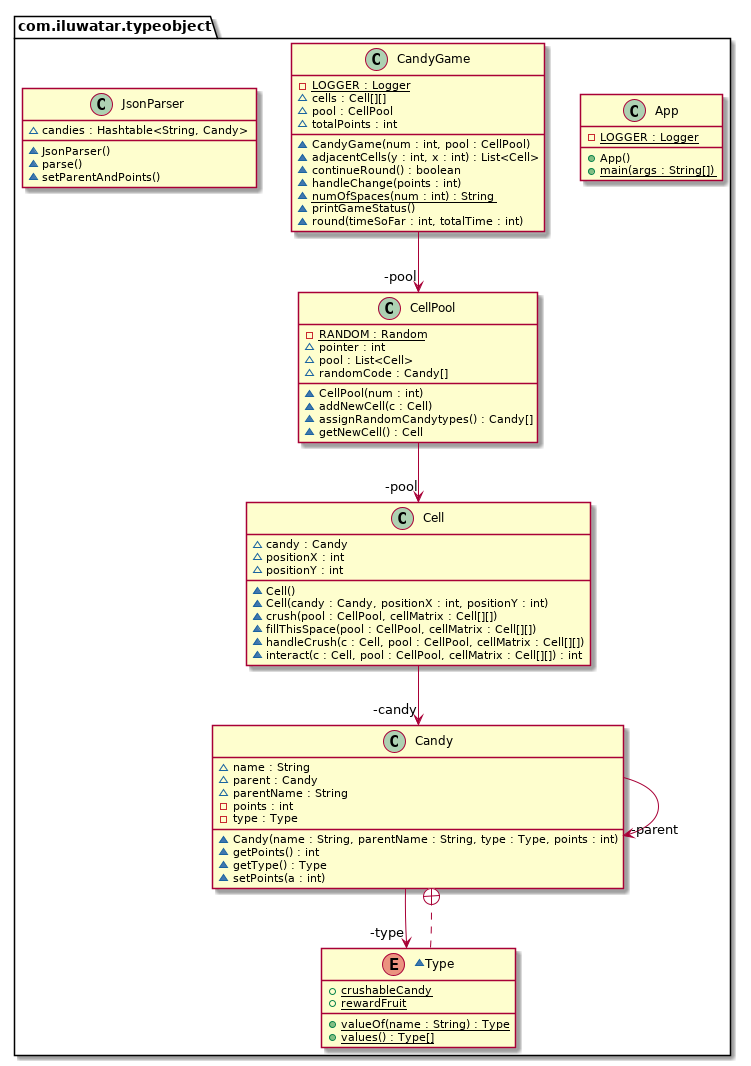Type-Object
Intent
As explained in the book Game Programming Patterns by Robert Nystrom, type object pattern helps in
Allowing flexible creation of new “classes” by creating a single class, each instance of which represents a different type of object
Explanation
Real-world example
You are working on a game with many different breeds of monsters. Each monster breed has different values for the attributes, such as attack, health, intelligence, etc. You want to create new monster breeds, or modify the attributes of an existing breed, without needing to modify the code and recompiling the game.
In plain words
Define a type object class, and a typed object class. We give each type object instance a reference to a typed object, containing the information for that type.
Programmatic example
Suppose we are developing a game of Candy Crush. There are many different candy types, and we may want to edit or create new ones over time as we develop the game.
First, we have a type for the candies, with a field name, parent, points and Type.
@Getter(AccessLevel.PACKAGE)
public class Candy {
enum Type {
CRUSHABLE_CANDY,
REWARD_FRUIT
}
String name;
Candy parent;
String parentName;
@Setter
private int points;
private final Type type;
Candy(String name, String parentName, Type type, int points) {
this.name = name;
this.parent = null;
this.type = type;
this.points = points;
this.parentName = parentName;
}
}
The field data for candy types are stored in the JSON file candy.json. New candies can be added just by appending it to this file.
{"candies" : [
{
"name" : "fruit",
"parent" : "null",
"type" : "rewardFruit",
"points" : 20
},
{
"name" : "candy",
"parent" : "null",
"type" : "crushableCandy",
"points" : 10
},
{
"name" : "cherry",
"parent" : "fruit",
"type" : "rewardFruit",
"points" : 0
},
{
"name" : "mango",
"parent" : "fruit",
"type" : "rewardFruit",
"points" : 0
},
{
"name" : "purple popsicle",
"parent" : "candy",
"type" : "crushableCandy",
"points" : 0
},
{
"name" : "green jellybean",
"parent" : "candy",
"type" : "crushableCandy",
"points" : 0
},
{
"name" : "orange gum",
"parent" : "candy",
"type" : "crushableCandy",
"points" : 0
}
]
}
The JSON file is parsed, instanciating each Candy type, and storing it in a hashtable. The type field is matched with the Type enum defined in the Candy class.
public class JsonParser {
Hashtable<String, Candy> candies;
JsonParser() {
this.candies = new Hashtable<>();
}
void parse() throws JsonParseException {
var is = this.getClass().getClassLoader().getResourceAsStream("candy.json");
var reader = new InputStreamReader(is);
var json = (JsonObject) com.google.gson.JsonParser.parseReader(reader);
var array = (JsonArray) json.get("candies");
for (var item : array) {
var candy = (JsonObject) item;
var name = candy.get("name").getAsString();
var parentName = candy.get("parent").getAsString();
var t = candy.get("type").getAsString();
var type = Type.CRUSHABLE_CANDY;
if (t.equals("rewardFruit")) {
type = Type.REWARD_FRUIT;
}
var points = candy.get("points").getAsInt();
var c = new Candy(name, parentName, type, points);
this.candies.put(name, c);
}
setParentAndPoints();
}
void setParentAndPoints() {
for (var e = this.candies.keys(); e.hasMoreElements(); ) {
var c = this.candies.get(e.nextElement());
if (c.parentName == null) {
c.parent = null;
} else {
c.parent = this.candies.get(c.parentName);
}
if (c.getPoints() == 0 && c.parent != null) {
c.setPoints(c.parent.getPoints());
}
}
}
}
In Plain Words
The Type-Object pattern in Java is a method to encapsulate type-specific properties and behaviors within an object. This design pattern facilitates the addition of new types without necessitating changes to existing code, thereby enhancing codebase expansion and maintenance.
Wikipedia Says
While there isn't a specific Wikipedia entry for the Type-Object pattern, it is a commonly used technique in object-oriented programming. This pattern assists in managing objects that share similar characteristics but have different values for those characteristics. It finds widespread use in game development, where numerous types of objects (like enemies) share common behavior but have different properties.
Programmatic Example
Consider an example involving different types of enemies in a game. Each enemy type has distinct properties like speed, health, and damage.
public class EnemyType {
private String name;
private int speed;
private int health;
private int damage;
public EnemyType(String name, int speed, int health, int damage) {
this.name = name;
this.speed = speed;
this.health = health;
this.damage = damage;
}
// getters and setters
}
public class Enemy {
private EnemyType type;
// Encapsulating type information in an object
public Enemy(EnemyType type) {
this.type = type;
}
// other methods
}
In the above example, EnemyType encapsulates type-specific properties (name, speed, health, damage), and Enemy uses an instance of EnemyType to define its type. This way, you can add as many enemy types as you want without modifying the Enemy class.
Applicability
This pattern can be used when:
- We don’t know what types we will need up front.
- We want to be able to modify or add new types without having to recompile or change code.
- Only difference between the different 'types' of objects is the data, not the behaviour.
Another example with class diagram
